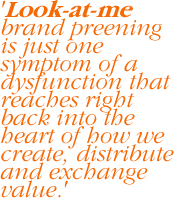

 |
 |
Chapter summary
Brand narcissism
In a recent show in London, US comic Michael Moore brought one sketch to a crescendo by taking out a pair of scissors and snipping a loyalty card in two. “Say after me!,” he shouted. “I am loyal to myself! I am loyal to my community! I am NOT loyal to a corporation!”.
‘Loyalty’ never was a very good word to describe repeat purchase. But the words we choose have habit of betraying our underlying attitudes and assumptions. Marketers conjured up the word loyalty because in their dreams consumers are, indeed, loyal to their brands.
A human being ‘loyal’ to a soap powder? Or a bank account? Or an airline? As soon as we stop to think about it, we can see how absurd this notion is. Yet such absurdity is so common nowadays that no one (except a few iconoclastic comedians) blinks an eye. This absurdity is a disease: the endemic disease of brand narcissism.
In Greek legend, Narcissus was the poor creature who was so enraptured by the sight of his own reflection that he pined away, gazing at it until he died. Modern psychiatrists classify narcissism as a clearly identifiable personality disorder.
According to the American Psychiatric Association’s reference bible
DSM IV, the narcissistically wounded personality tends to display some
or all of the following attributes:
1) a grandiose sense of self-importance;
2) fantasies of unlimited success, power and brilliance;
3) a belief that one is superior, special and unique;
4) a constant seeking for attention and admiration;
5) a preoccupation with how well I am doing and how favourably I am regarded
by others.
A personality disorder? Or a brand manager’s job description? You take your pick, because the similarities are striking. After all, 'Look at me! Look at how wonderful and attractive I am!' is the fundamental agenda of advertising, direct marketing, public relations, sponsorship, and so on: no brand ever got successful by being a shrinking violet.
Does this similarity matter? Who cares if marketers sometimes use silly words like ‘loyalty’? Isn’t it a trifle condescending to suppose that marketers and their publics can’t cope with a bit of narcisisstic preening? We all take it with a pinch of salt anyway, don’t we? Perhaps we do. But that’s not the point.
‘Look at me!’ brand preening is just one, superficial, symptom of a dysfunction that reaches right back into the heart of how we create, distribute and exchange value. The problem with narcissists is that they only understand their relationships with other people in terms of themselves.
They are only interested in other people to the extent and degree that these other people provide them with a mirror in which to further regard themselves. They use other people for their own purposes – their own self-glorification. And because they so routinely use people for their own narcissistic ends they want as friends. In fact, precisely because use other people for their own ends, they have a habit of hurting and disappointing, turning many a friend into an enemy along the way.
Brand narcissism is very similar. It attempts to use people for the purposes of the brand, in so doing destroys the win-win heart of branding.
Read more in the full book
Next chapter: Can You Go Beyond Brand?
